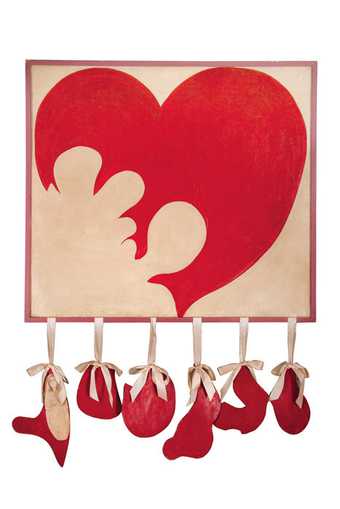Was ‘pop art’ a term used by yourself or colleagues or was there a different terminology that referred to a new figurative art movement in the 1960s and early 1970s?
At the beginning of the 1960s I was just out of art school. I was doing collages including real pieces of female and male clothing and photos from magazines. It was only when I started to be invited to exhibitions at the Torcuato di Tella Institute [in Buenos Aires] that I became aware of pop as a movement.
Did you ever consider yourself (now or in the past) a pop artist?
Pop, it was a label that I accepted. But I don’t like categories, neither in art nor in life.
Did your work engage with current events in the 1960s and early 1970s?
Yes, I was interested in the conditions of women, and in everything that was happening in Europe. For instance, the English cinema and the French Nouvelle vague, particularly Jean-Luc Godard, European pop music and fashion.

Delia Cancela
Broken Heart 1964
Private collection
© Delia Cancela
How did you choose the subject matter for your work included in The World Goes Pop?
The subject matter for my work was the idea of the heart as a symbol of womanhood, as in popular women’s magazines. That is to say, a symbol emerged from the mass media, a kind of naive image of women.
Where did you get your imagery from (what, if any, sources did you use)?
Magazines (all of kinds) were part of my inspiration. My father was working in the press distribution and so all the magazines were available at my house.
Were you aware of pop art in other parts of the world?
In 1965, American pop art arrived at the Di Tella Institute. The exhibition New America Cinema introduced Andy Warhol and Paul Morrissey movies. Other exhibitions featured paintings from American pop artists. But it was not until the 1970s that I discovered English pop.
Was commercial art an influence on your work or the way in which it was made?
In 1965, I started working with Pablo Mesejean, my life partner. We were influenced by the big advertising posters for cinema and pop music. In fact, in 1966, for the Di Tella Prize we presented our manifesto, Nosotros Amamos (We Love). It was in support of the international pop culture of the time. We also showed a triptych, Muchachas y Muchachos (‘Girls and Boys’), six portraits of pop singers.
‘We love sunny days, plants, the Rolling Stones, white, pink and silver stockings, Sonny and Cher, Rita Tushingham and Bob Dylan. Furs, Saint-Laurent and the Young Savages look, the music hits of today, the countryside, pink and blue, shirts with flowers prints, shirts with stripes, having our picture taken, long hair, Alice in Wonderland, suntanned bodies, colourful caps, white powered faces and happy endings, the sea, dancing, magazines, the movies, sable, Ringo and Antoine, the colour black, shiny clothes, baby girls, girl-girls, boy-girls, girl-boys, and boy-boys’.
Delia Cancela and Pablo Mesejean. Buenos Aires, 1966
Was there a feeling at the time that you doing something important and new, making a change…?
My slogan at that time was ‘Freedom and Irreverence’. It still is. Since I knew the past I was focused on the present.
Was there an audience for the work at the time – and if so what was their reaction to it?
There was very little audience, aside from the persecutions … I lived in Paris for a year in 1967 in and then in 1969 I left Argentina, to go first to New York and then to London and again to Paris.
Looking back at these works, what you do think about them now?
Well, I would like to have your opinion about those works! However, I think they were something new and unusual for their time in Argentina.
September 2015
